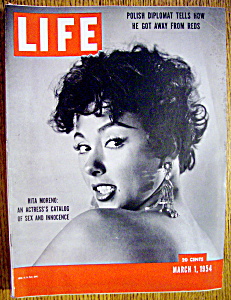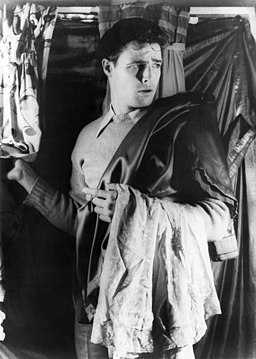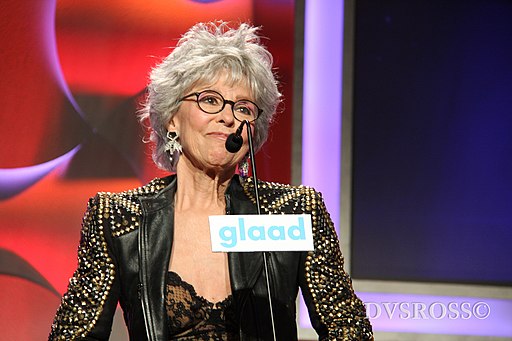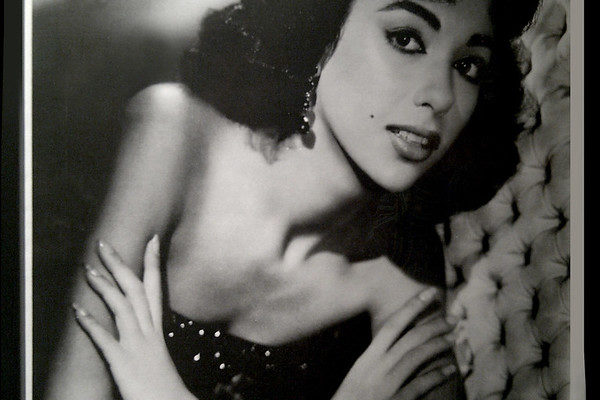“This idea lasts through my whole life: I always play a part. For so many years, I have to be a ‘smoldering sexy spitfire.’ Rita Moreno – funny and bold and golden as all her statuettes. The Hispanic heroine with all four gleaming prizes – Oscar, Tony, Emmy, Grammy – big money, hot lovers, ‘perfect’ forty-five-year marriage, with a gold medal hanging around my necks and shelves filled with award statuettes but still, inside, who is she? Who am I? Rosita Dolores Alverio? Or Rita Moreno? Rita or Rosita? Who am I?” from Rita Moreno, A Memoir.
Even Spitfires Start as Little Girls
Born December 11, 1931 in Humacao, Puerto Rico, raised in Juncos, Rosita Dolores was the daughter of Rosa María (Marcano) and Paco José Alverio. Wikipedia states her father was a farmer, but seamstress mother Rosa apparently felt her husband was plowing more than fields. She transplanted herself and her five year old daughter from the “ice-cream houses” of Juncos to cold, gritty and gray New York City in 1936, leaving behind a three-year old son.
After being hospitalized in New York for chicken pox and terrified by not understanding a word being spoken around her, Rosita resolved to learn inglés perfectly, and to speak it without accent.
She enjoyed dancing, and as their fortunes improved, Rosa arranged for her daughter to take Spanish dance lessons with Rita Hayworth’s uncle. Rosita loved performing and appeared on Broadway at age 13 in a short-lived play called Skydrift. Upon securing an appointment with MGM head Louis B. Mayer, Rosita and her mother designed dress and makeup to mimic the appearance of her favorite movie star, sure that would impress him.
It worked. The “Spanish Elizabeth Taylor” was signed to a seven year contract. Talent agent Bill Grady would rename her Rita, with Moreno being the name of her (second) stepfather (out of five she would eventually have).
Perfecting the Universal Ethnic Accent
In New York, polite people called Puerto Ricans “PR’s,” while others yelled “Spic!” and sometimes chased or beat them up. White in Puerto Rico, among a people whose skin tones ranged from white to true black, little Rosita Alverio was considered light-skinned, but in 1950’s Hollywood, Rita Moreno was considered dark-skinned and exotic, despite her perfect, accentless English. Rarely was she offered a part that was simply a character – rather than an ethnic character, though Gene Kelley tagged her to play Zelda Zanders, the snitch and “Zip Girl” in Singin’ in the Rain.
Because directors demanded an accent (and rarely supplied a dialect coach), Rita invented something she called a “Universal Ethnic Accent,” and used it to play Tina (Cajun) in The Toast of New Orleans, Terru (Tahitian) in 1950’s Pagan Love Song, Honey Bear (Native American) in The Yellow Tomahawk, Jara (Arabian) in El Alamein, Lola Montalvo (Hispanic) in This Rebel Breed, and many other minority parts. Memorably, she played Tuptim (the king’s concubine) in The King and I. While loathing the stereotyping, the made-up accent, and the often terrible brown makeup, at the same time, at least it was work. Hollywood certainly had no qualms about slapping the same brown pancake makeup on white actors and actresses for the “ethnic” roles, should she turn them down. In her Memoir, she says:
As I look back on my Indian maiden period, I can see that the films also all had a barely veiled sexist slant: that girls should be captured, writhing, and either enjoy submitting or kick till the bitter end. The Arab maidens did the same thing. All maidens ultimately spoke in sibilant subservient whispers when they ‘caved’ to warrior chieftains, super cowboys, sheikhs, or white liberators of captured maidens.
Rita was also called upon, as starlets were, to go on public dates with various stars. Theatre openings. Nightclubs and parties, wearing glamorous dresses loaned by the studios, “to be eye candy, to decorate its opening events and parties like so many bright, sweetly scented flowers.”
And then without warning, her MGM contract was cancelled. Time to schlep all over town for audition after audition, for the same crappy, sexist, ethnic parts. Somehow, while shooting a television pilot with Ray Bolger, she ended up on the March 1, 1954 cover of Life magazine, as Rita Moreno: An Actress’s Catalog of Sex and Innocence. Now she was contracted by Universal.

Rita and Marlon and Elvis, Oh My!
Howard Hughes asked her out on some bizarre dates. She dated Geordie Hormel. Anthony Quinn.
But the crazylove of Rita’s love was Marlon Brando, who became intrigued by that Life cover, but couldn’t find that girl. Later, they met on the set of Marlon’s movie Desiree. She was 23, he was 30. At the time, he was at the top of his game, handsome, and well-built.

We grew intimate quickly, and I began spending a lot of time at Marlon’s house. To say that he was a great lover – sensual, generous, delightfully inventive – would be gravely understating what he did not only to my body, but for my soul. Every aspect of being with Marlon was thrilling, because he was more engaged in the world than anyone else I’d ever known.
Their affair was on-again, off-again, over the course of eight years. He got other women pregnant, married them, divorced them. She went out with Dennis Hopper, and Elvis Presley, to make Marlon jealous. She began seeing a therapist.
Rita allowed herself to become pregnant, and to her soul-wounding shock, instead of marrying her, Marlon insisted upon an abortion. Botched, she had to be hospitalized.
I must have had at least five or six breakups with Marlon, only to return to his bed after massive wooing and purring and dinners and implied promises that things would be all right once he returned. But here’s the rub: Those ‘morning after’ drives in my car back to my house after giving in to Marlon yet again were among my sorriest, saddest experiences. I felt used and thoroughly humiliated every time. Empty, the life sucked out [of] me. And at the same time, sooo disappointed in myself, which made me feel even worse, if that was possible.
In April 1961 Rita attempted suicide In Marlon Brando’s house. Not a feint, but an act of weariness, of hitting bottom, feeling worthless and rejected by the whole world, including her lover who seemed to want every other “ethnic” woman in the world to bear his babies – but not Rita.
She survived, but in order to truly thrive, she had to end the emotional roller-coaster affair with Marlon Brando – and he had to leave her be.
West Side Story Salvation
While I had been balking all my life at playing stereotyped Hispanic roles in the movies, all those Conchitas and Lolitas, I leaped at the opportunity to audition for the part of Anita. Anita was real! She was Puerto Rican, and she was fighting for her rights…. At this point, I’d never been given the opportunity to play the part of a woman who stood up for herself. Her suffering, her anger, were my suffering, my anger. Becoming Anita was a personal mission for me. I had fled down those mean streets in fear of the gangs, chased and haunted by that awful hiss: ‘Spic!’
Although Chita Rivera did an excellent job in the 1957 stage play, Rita Moreno nailed Anita. (And she got to use a genuine Puerto Rican accent!)
Filmed during the tail end of Rita’s tempestuous relationship with Marlon Brando, she and co-star George Chakiris (a Greek playing Hispanic Bernardo) would pick up matching Oscars for West Side Story in April 1962.
Surely after that triumph, the offers for strong, meaty, non-stereotypical roles would come pouring in?
No, not so much.
Marriage, Mami-hood, Muppets, and Morgan Freeman
Rita became more politically active, appearing and speaking at rallies for civil rights, attending the March on Washington and hearing Dr. Martin Luther King’s “I Have A Dream” speech in person. She also became romantically involved with SNCC executive secretary James Forman. She turned down a photo opp to be in one of Kenneth Tynan’s spanking scrapbooks.
Next, Rita took a detour from the “sexy spitfire” gang member and prostitute roles, which were all that were being offered to her, marrying New York cardiologist Leonard Gordon in 1965, and starting a family with him.
Rita adored daughter Fernanda, but also still had the drive to perform. And she wasn’t dead-set against sexy roles, if they were good parts, not stereotypes. She made a film with her ex, Marlon Brando, in 1968, The Night of the Following Day, and appeared in Carnal Knowledge with Jack Nicholson, Art Garfunkel, Candice Bergen and Ann-Margret in 1971. She had a leading role in The Four Seasons, in 1981, with Alan Alda and Carol Burnett.
But she wasn’t eighteen anymore, nor even in her twenties. Compared to men’s roles, even today the film role pickings are slim for actresses of a certain age.
So, Rita did television. 780 episodes and a Grammy for The Electric Company, which also starred Morgan Freeman, Bill Cosby, Judy Graubart and others. The Muppet Show (Emmy in 1977). Guest starring on various series, from The Love Boat to The Rockford Files (another Emmy). Later she’d voice Carmen Sandiego, and play a nun for 44 episodes of the critically acclaimed drama Oz.
Rita also did Broadway, earning a Tony for her role in The Ritz, and recently performed an autobiographical stage play in Berkeley, Life Without Makeup. She had a recurring role in the TV series Happily Divorced, which ran for two seasons, Jane the Virgin, and in many other series, including *squee* a part in the upcoming West Side Story remake.
Add Author to the List
In March 2013, Rita Moreno released her Memoir, from which most excerpts here are taken. She wrote about her life, her work, and her loving if imperfect marriage .
In 2017, she began yet another series, as Lydia Riera on the rebooted One Day At A Time, playing a character younger than herself. (Hollywood doesn’t do that.)
In 2019, Rita received a Peabody (Lifetime Achievement award). So, she’s a PEGOT: Peabody, Emmy, Grammy, Oscar, and Tony — one of only three in American history.
Oh yeah, she’s also been awarded the Presidential Medal of Freedom, the National Medal of Arts, the Screen Actors Guild Life Achievement Award, and a bunch of other shiny prizes. Somehow, despite sexism, racism, and ageism, and a life that some would call “slutty,” beautiful, talented Rita Moreno continues to appeal to an audience of all ages.

About the Great Sluts in History series:
What makes a woman a “slut,” anyway? From Lillith to Jezebel to Sandra Fluke, it seems that whenever women are in positions of power, open about their sexuality, “too outspoken,” or heaven forbid, all three, they are labeled sluts by some men (and sometimes other women), in an attempt to shame them into “knowing their place.” And into meekly accepting “their place.”This series will look at flawed and wonderful heroines throughout history who insisted on “Following their own weird,” no matter how much it cost them to do so. And how, by doing so, they made the world better for all humans, of all genders, who followed them.
“…it is no longer acceptable to discuss women’s rights as separate from human rights… If there is one message that echoes forth from this conference, let it be that human rights are women’s rights and women’s rights are human rights, once and for all.” ~Hillary Rodham Clinton, 1995
This is an updated version of the Slut essay originally published on my blog in 2013.
Are you as impressed as I am that Ms. Moreno is still going strong, in her eighties?
What does it say about her that she survived 1950’s Hollywood?
Your thoughts?

